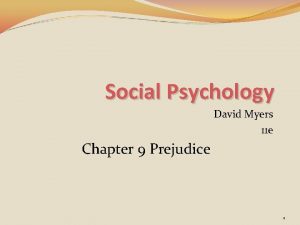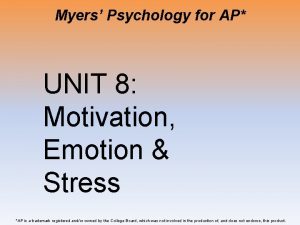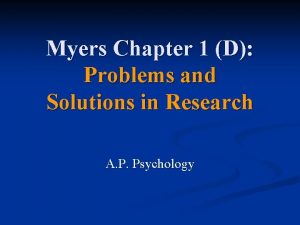Myers Psychology for AP David G Myers Power


















































































- Slides: 82

Myers’ Psychology for AP* David G. Myers Power. Point Presentation Slides by Kent Korek Germantown High School Worth Publishers, © 2010 *AP is a trademark registered and/or owned by the College Board, which was not involved in the production of, and does not endorse, this product.

Unit 8 B: Motivation and Emotion: Emotions, Stress and Health

Unit Overview • • • Theories of Emotion Embodied Emotion Expressed Emotion Experienced Emotion Stress and Health Click on the any of the above hyperlinks to go to that section in the presentation.

Theories of Emotion

Theories of emotions • Emotion – Physiological arousal – Expressive behavior – Conscious experience • Common sense theory

Theories of emotions • James-Lange theory

Theories of emotions • James-Lange theory

Theories of emotions • James-Lange theory

Theories of emotions • Cannon-Bard theory

Theories of emotions • Cannon-Bard theory

Theories of emotions • Two-factor theory – Schachter-Singer

Theories of emotions • Two-factor theory – Schachter-Singer

Theories of emotions • Two-factor theory – Schachter-Singer

Theories of emotions

Embodied Emotion

Emotions and the Autonomic Nervous System • Autonomic nervous system – Sympathetic nervous system • arousing – Parasympathetic nervous system • Calming – Moderate arousal is ideal

Emotions and the Autonomic Nervous System

Emotions and the Autonomic Nervous System

Emotions and the Autonomic Nervous System

Physiological Similarities Among Specific Emotions • Different movie experiment

Physiological Differences Among Specific Emotions • Differences in brain activity – Amygdala- fear – Frontal lobes • Right: (-) emotions • Left: (+) emotions – Full of dopamine receptors – Nucleus accumbens » Natural/drug-induced pleasure – Polygraph

Cognition and Emotion Cognition Can Define Emotion • Spill over effect – Schachter-Singer experiment • Arousal fuels emotions, cognition channels it

Cognition and Emotion Cognition Does Not Always Precede Emotion • Influence of the amygdala

Expressed Emotion

Detecting Emotion • Nonverbal cues – Duchenne smile (activated muscles under the eyes and raised cheeks= natural smile) • Authentic expressions fade before 4 -5 seconds

Gender, Emotion, and Nonverbal Behavior

Gender, Emotion, and Nonverbal Behavior

Culture and Emotional Expression

Levels of Analysis for the Study of Emotion

Levels of Analysis for the Study of Emotion

Levels of Analysis for the Study of Emotion

Levels of Analysis for the Study of Emotion

The Effects of Facial Expressions • Facial feedback

Experienced Emotion

Fear • Adaptive value of fear • The biology of fear – amygdala

Anger • Anger – Evoked by events – Evoked by loved ones misdeeds • Especially when willful, unjustified, and avoidable – Catharsis – Expressing anger can increase anger can • Expressing anger as a non-accusing statement of feelings can benefit relationships by leading to reconciliation rather than retaliation

Happiness • Happiness – Feel-good, do-good phenomenon – Well-being

Happiness The Short Life of Emotional Ups and Downs • Watson’s studies

Happiness Wealth and Well-Being

Happiness Wealth and Well-Being

Happiness Two Psychological Phenomena: Adaptation and Comparison • Happiness and Prior Experience – Adaptation-level phenomenon • Happiness and others’ attainments – Relative deprivation

Happiness Predictors of Happiness

Stress and Health

Introduction • Health psychology • Behavioral medicine

Stress and Illness • Stress – Stress appraisal • Challenges vs. Threats v. Psychology 35

Stress and Illness The Stress Response System • Selye’s general adaptation syndrome (GAS) – Alarm • Due to the sudden activation of SNS – Resistance • Fight stressor • Sudden outpouring of stress hormones – Exhaustion • Become more vulnerable to illness

Stress and Illness General Adaptation Syndrome

Stress and Illness General Adaptation Syndrome

Stress and Illness General Adaptation Syndrome

Stress and Illness General Adaptation Syndrome

Stress and Illness Stressful Life Events • Catastrophes • Significant life changes • Daily hassles

Stress and the Heart • Coronary heart disease • Type A versus Type B – Type A – Type B v. The Mind 4

Stress and Susceptibility to Disease • Psychophysiological illnesses • Psychoneuroimmunology (PNI) – Lymphocytes • B lymphocytes – Bacterial infections • T lymphocytes – Cancer, viruses, foreign substances – Stress and AIDS – Stress and Cancer

The End

• Types of Files Teacher Information – This presentation has been saved as a “basic” Powerpoint file. While this file format placed a few limitations on the presentation, it insured the file would be compatible with the many versions of Powerpoint teachers use. To add functionality to the presentation, teachers may want to save the file for their specific version of Powerpoint. • Animation – Once again, to insure compatibility with all versions of Powerpoint, none of the slides are animated. To increase student interest, it is suggested teachers animate the slides wherever possible. • Adding slides to this presentation – Teachers are encouraged to adapt this presentation to their personal teaching style. To help keep a sense of continuity, blank slides which can be copied and pasted to a specific location in the presentation follow this “Teacher Information” section.

Teacher Information • Hyperlink Slides - This presentation contain two types of hyperlinks. Hyperlinks can be identified by the text being underlined and a different color (usually purple). – Unit subsections hyperlinks: Immediately after the unit title slide, a page (slide #3) can be found listing all of the unit’s subsections. While in slide show mode, clicking on any of these hyperlinks will take the user directly to the beginning of that subsection. This allows teachers quick access to each subsection. – Bold print term hyperlinks: Every bold print term from the unit is included in this presentation as a hyperlink. While in slide show mode, clicking on any of the hyperlinks will take the user to a slide containing the formal definition of the term. Clicking on the “arrow” in the bottom left corner of the definition slide will take the user back to the original point in the presentation. These hyperlinks were included for teachers who want students to see or copy down the exact definition as stated in the text. Most teachers prefer the definitions not be included to prevent students from only “copying down what is on the screen” and not actively listening to the presentation. For teachers who continually use the Bold Print Term Hyperlinks option, please contact the author using the email address on the next slide to learn a technique to expedite the returning to the original point in the presentation.

Teacher Information • Continuity slides – Throughout this presentation there are slides, usually of graphics or tables, that build on one another. These are included for three purposes. • By presenting information in small chunks, students will find it easier to process and remember the concepts. • By continually changing slides, students will stay interested in the presentation. • To facilitate class discussion and critical thinking. Students should be encouraged to think about “what might come next” in the series of slides. • Please feel free to contact me at kkorek@germantown. k 12. wi. us with any questions, concerns, suggestions, etc. regarding these presentations. Kent Korek Germantown High School Germantown, WI 53022 262 -253 -3400 kkorek@germantown. k 12. wi. us

Division title (green print) subdivision title (blue print) • xxx – xxx

Division title (green print) subdivision title (blue print) Use this slide to add a table, chart, clip art, picture, diagram, or video clip. Delete this box when finished

Definition Slide = add definition here

Definition Slides

Emotion = a response of the whole organism, involving (1) physiological arousal, (2) expressive behaviors, and (3) conscious experience.

James-Lange Theory = theory that our experience of emotion is our awareness of our physiological responses to emotion-arousing stimuli.

Cannon-Bard Theory = theory that an emotion-arousing stimulus simultaneously triggers (1) physiological responses and (2) the subjective experience of emotion.

Two-factor Theory = the Schachter-Singer theory that to experience emotion one must (1) be physically aroused and (2) cognitively label the arousal.

Polygraph = a machine, commonly used in attempts to detect lies, that measure several of the physiological responses accompanying emotion (such as perspiration and cardiovascular and breathing changes).

Facial Feedback = the effect of facial expressions on experienced emotions, as when a facial expression of anger or happiness intensifies feelings of anger or happiness.

Catharsis = emotional release. The catharsis hypothesis maintains that “releasing’ aggressive energy (through action or fantasy) relieves aggressive urges.

Feel-Good Do-Good Phenomenon = people’s tendency to be helpful when already in a good mood.

Well-being = self-perceived happiness or satisfaction with life. Used along with measures of objective well-being (for example, physical and economic indicators) to evaluate people’s quality of life.

Adaptation-level Phenomenon = our tendency to form judgments (of sounds, of lights, of income) relative to a neutral level defined by our prior experience.

Relative Deprivation = the perception that we are worse off relative to those with whom we compare ourselves.

Behavioral Medicine = an interdisciplinary field that integrates behavior and medical knowledge and applies that knowledge to health and disease. .

Health Psychology = a subfield of psychology that provides psychology's contribution to behavioral medicine.

Stress = the process by which we perceive and respond to certain events, called stressors, that we appraise as threatening or challenging.

General Adaptation Syndrome (GAS) = Selye’s concept of the body’s adaptive response to stress in three phases – alarm, resistance, exhaustion.

Coronary Heart Disease = the clogging of the vessels that nourish the heart muscle; the leading cause of death in North America.

Type A = Friedman and Rosenman’s term for competitive, hard-driving, impatient, verbally aggressive, and anger-prone people.

Type B = Friedman and Rosenman’s term for easygoing, relaxed people.

Psychophysiological Illness = literally, “mind-body” illness; any stressrelated physical illness, such as hypertension and some headaches.

Psychoneuroimmunology (PNI) = the study of how psychological, neural, and endocrine processes together affect the immune system and resulting health.

Lymphocytes = the two types of white blood cells that are part of the body’s immune system; B lymphocytes form in the bone marrow and release antibodies that fight bacterial infections; T lymphocytes form in the thymus and other lymphatic tissue and attack cancer cells, viruses, and foreign substances.
 David myers psychology 9th edition
David myers psychology 9th edition Psychology eighth edition david g myers
Psychology eighth edition david g myers Reuptake psychology
Reuptake psychology General adaptation syndrome
General adaptation syndrome Psychology tenth edition in modules
Psychology tenth edition in modules Self-perpetuating prejudgments
Self-perpetuating prejudgments Ap psychology unit 8 motivation emotion and stress
Ap psychology unit 8 motivation emotion and stress Myers psychology for ap
Myers psychology for ap Myers' psychology for ap solutions
Myers' psychology for ap solutions Psychology in everyday life myers
Psychology in everyday life myers Myers' psychology for ap
Myers' psychology for ap Triangle of power
Triangle of power Kontinuitetshantering
Kontinuitetshantering Typiska drag för en novell
Typiska drag för en novell Nationell inriktning för artificiell intelligens
Nationell inriktning för artificiell intelligens Returpilarna
Returpilarna Varför kallas perioden 1918-1939 för mellankrigstiden?
Varför kallas perioden 1918-1939 för mellankrigstiden? En lathund för arbete med kontinuitetshantering
En lathund för arbete med kontinuitetshantering Kassaregister ideell förening
Kassaregister ideell förening Tidböcker
Tidböcker A gastrica
A gastrica Förklara densitet för barn
Förklara densitet för barn Datorkunskap för nybörjare
Datorkunskap för nybörjare Tack för att ni lyssnade bild
Tack för att ni lyssnade bild Debattinlägg mall
Debattinlägg mall Delegerande ledarskap
Delegerande ledarskap Nyckelkompetenser för livslångt lärande
Nyckelkompetenser för livslångt lärande Påbyggnader för flakfordon
Påbyggnader för flakfordon Lufttryck formel
Lufttryck formel Svenskt ramverk för digital samverkan
Svenskt ramverk för digital samverkan Bo bergman jag fryser om dina händer
Bo bergman jag fryser om dina händer Presentera för publik crossboss
Presentera för publik crossboss Teckenspråk minoritetsspråk argument
Teckenspråk minoritetsspråk argument Vem räknas som jude
Vem räknas som jude Klassificeringsstruktur för kommunala verksamheter
Klassificeringsstruktur för kommunala verksamheter Luftstrupen för medicinare
Luftstrupen för medicinare Bästa kameran för astrofoto
Bästa kameran för astrofoto Cks
Cks Programskede byggprocessen
Programskede byggprocessen Mat för idrottare
Mat för idrottare Verktyg för automatisering av utbetalningar
Verktyg för automatisering av utbetalningar Rutin för avvikelsehantering
Rutin för avvikelsehantering Smärtskolan kunskap för livet
Smärtskolan kunskap för livet Ministerstyre för och nackdelar
Ministerstyre för och nackdelar Tack för att ni har lyssnat
Tack för att ni har lyssnat Referat mall
Referat mall Redogör för vad psykologi är
Redogör för vad psykologi är Borstål, egenskaper
Borstål, egenskaper Atmosfr
Atmosfr Borra hål för knoppar
Borra hål för knoppar Vilken grundregel finns det för tronföljden i sverige?
Vilken grundregel finns det för tronföljden i sverige? Formula varians
Formula varians Tack för att ni har lyssnat
Tack för att ni har lyssnat Rita perspektiv
Rita perspektiv Verksamhetsanalys exempel
Verksamhetsanalys exempel Tobinskatten för och nackdelar
Tobinskatten för och nackdelar Toppslätskivling effekt
Toppslätskivling effekt Mästare lärling modell
Mästare lärling modell Egg för emanuel
Egg för emanuel Elektronik för barn
Elektronik för barn Antikt plagg i rom
Antikt plagg i rom Strategi för svensk viltförvaltning
Strategi för svensk viltförvaltning Kung dog 1611
Kung dog 1611 Ellika andolf
Ellika andolf Ro i rom pax
Ro i rom pax Tack för att ni lyssnade
Tack för att ni lyssnade Multiplikation med decimaltal uppgifter
Multiplikation med decimaltal uppgifter Anafor dikt
Anafor dikt Inköpsprocessen steg för steg
Inköpsprocessen steg för steg Fuktmätningar i betong enlig rbk
Fuktmätningar i betong enlig rbk Ledarskapsteorier
Ledarskapsteorier Hur stor skarns är det för ett barn att få cancer
Hur stor skarns är det för ett barn att få cancer Myndigheten för delaktighet
Myndigheten för delaktighet Frgar
Frgar Tillitsbaserad ledning
Tillitsbaserad ledning Läkarutlåtande för livränta
Läkarutlåtande för livränta Karttecken ruin
Karttecken ruin Gumman cirkel sång
Gumman cirkel sång Shivaismen
Shivaismen Var finns arvsanlagen
Var finns arvsanlagen Bris för vuxna
Bris för vuxna Bamse för de yngsta
Bamse för de yngsta Mental quality consisting of the ability to learn
Mental quality consisting of the ability to learn









































































































